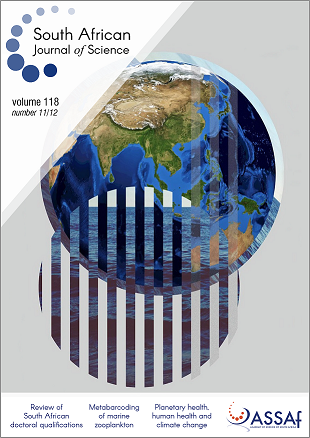Will the grass be greener on the other side of climate change? (with corrigendum)
DOI:
https://doi.org/10.17159/sajs.2022/13844Keywords:
climate change, forage quality, sourveld, mixed veld, sweetveldAbstract
Increasing atmospheric [CO2] is stimulating photosynthesis and plant production, increasing the demand for nitrogen relative to soil supply with declining global foliar nitrogen concentrations as a consequence. The effects of such oligotrophication on the forage quality of sweetveld, mixed veld, and sourveld grasslands in South Africa, which support livestock production and native ungulates, are unknown. Soil characteristics and the herbage quality of an abundant grass are described from baseline historical (mid- 1980s) data collected across a sweet-mixed-sour grassland gradient in KwaZulu-Natal. Sourveld occurred on the most acidic, dystrophic soils and exhibited a pronounced decline in leaf nitrogen, digestibility, and other macronutrients during winter, in sharp contrast to sweetveld, on nutrient-rich soils, where forage quality varied little seasonally. In a carbon-enriched, warmer, and most likely drier future climate, we predict that forage quality will not be substantially altered in sweetveld where soil nutrients and temperature are not limiting but that sourveld could become ‘sourer’ because soil nutrients will be inadequate to match higher plant production promoted by elevated [CO2] and warmer and longer growing seasons. Reassessing historical data and seasonal and spatial monitoring of forage quality will enable assessment of past and future impacts of climate change on grassland forage quality.
Significance:
- Grassland forage quality will likely decline with elevated [CO2] and warming, particularly in sourveld.
- Climate change could deepen and widen the sourveld winter forage bottleneck, necessitating greater supplementary feeding of livestock.
Downloads
Additional Files
Published
Issue
Section
License

All articles are published under a Creative Commons Attribution 4.0 International Licence
Copyright is retained by the authors. Readers are welcome to reproduce, share and adapt the content without permission provided the source is attributed.
Disclaimer: The publisher and editors accept no responsibility for statements made by the authors
How to Cite
- Abstract 776
- PDF 555
- EPUB 237
- XML 434
- Supplementary material 127
- Corrigendum 76












.png)